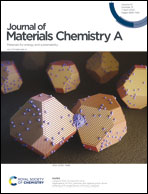On the mechanism of electrochemical functionalization of carbon nanotubes with different structures with aminophenylphosphonic acid isomers: an experimental and computational approach†
Abstract
Electrochemical functionalization of single-walled carbon nanotubes and herringbone carbon nanotubes (SWCNTs and hCNTs, respectively) has been successfully performed with aminophenylphosphonic acid isomers by potentiodynamic treatment under oxidative conditions. Exceptional selectivity and control of the functional species embedded into the carbon nanotubes (CNTs) have been achieved by carefully optimizing the electrochemical conditions in the functionalization. X-ray photoelectron spectroscopy (XPS) analysis determined a maximum heteroatom incorporation of ca. 2.3–2.6 at% N and 1.4–1.6 at% P when 2-aminophenylphosphonic acid (2APPA) is used with both carbon materials, probably because of the linear polymeric growth comparable to that of oligomers derived from aniline (ANI). However, the polymeric product obtained with 4-aminophenylphosphonic acid (4APPA) is much more limited, giving rise to a branched structure. In addition, electrochemical characterization, Raman spectroscopy and electron microscopy suggest that the SWCNT structure facilitates the oligomerization of longer but less stable chains through π–π interactions with the walls of CNTs, while hCNTs promote a more stable attachment according to their heterogeneity and higher reactivity. Computational calculations have confirmed the experimental results obtained, which allow us to shed more light on the mechanisms of the electrochemical functionalization of CNTs with phosphorus and nitrogen-containing polymers.



 Please wait while we load your content...
Please wait while we load your content...